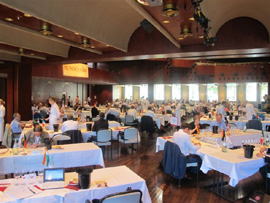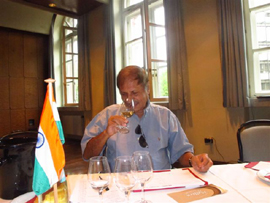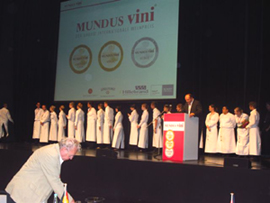 Based on the 3247 samples of red still wines submitted out of a total of 6028 wines submitted, one could assume that 54% of the wine drunk globally is red while 33% of wine is white (1984 samples). Only 3.19% of the samples submitted were Rose while around 8% of the wines were sparkling wines. Of course, the numbers are, at best only an estimate of the break -up of the main categories of wine and may not be the true global representation of the drinking pattern. Based on the 3247 samples of red still wines submitted out of a total of 6028 wines submitted, one could assume that 54% of the wine drunk globally is red while 33% of wine is white (1984 samples). Only 3.19% of the samples submitted were Rose while around 8% of the wines were sparkling wines. Of course, the numbers are, at best only an estimate of the break -up of the main categories of wine and may not be the true global representation of the drinking pattern.
It must be a sign of aggressive marketing push by Italy in the important German market that for the first time the samples submitted by a foreign county exceeded those by the German producers. Italians were the highest (1300) with Spain tailing Germany by 112. Of course, much lower crops of Germany in 2009 must have something to Germany sending much less samples at 1120 compared to 1477 last year, said Christoph Meininger, owner of the competition while reflecting the state of German market at the opening of the competition.
A majority of the 273 jurors from 48 countries were from Germany (104), Italy (18) and France (17). The balance 134 came from 45 countries from as far away as Chile, Argentina, New Zealand, the USA, Canada and Brazil, including the lone judge from India. It is a privilege for me to be invited for the 5th consecutive year, thus setting a record of sorts making me possibly the first Indian ever to be a judge of a major international wine competition for 5 years in a row.
MundusVini is of one of the biggest wine competitions in the world with the number of entries participating every year increasing from a bumper 2235 entries when it was started in 2001 to a record 6028 this year without a decrease in samples submitted in any year. Showing a growth even during the recent recession years must be a feather in the cap and a testimonial to the increasing respect this completion enjoys from the producers.
 The competition is conducted under the aegis of OIV-Organisation of International Vines and Wines and Union Internationale des Oenologues (UIOE) which mandate that not more than 45 (50 in exceptional cases) of samples may be tasted in a day. Each panel of international jurists numbering 5-7 contains 2-3 German judges but must also have 3-4 international judges. The 100-point system is used to award Silver (85 or more), Gold (90 or more) and Great Gold (95 or over) medals, subject to a maximum of 30% of the samples submitted. If two member desire, they may request for a second bottle if the first one is considered corked. However, if the fault is repeated in the second bottle, it must be disqualified. To calibrate the panel’s rating, every day one must start with a previously judged sample. The competition is conducted under the aegis of OIV-Organisation of International Vines and Wines and Union Internationale des Oenologues (UIOE) which mandate that not more than 45 (50 in exceptional cases) of samples may be tasted in a day. Each panel of international jurists numbering 5-7 contains 2-3 German judges but must also have 3-4 international judges. The 100-point system is used to award Silver (85 or more), Gold (90 or more) and Great Gold (95 or over) medals, subject to a maximum of 30% of the samples submitted. If two member desire, they may request for a second bottle if the first one is considered corked. However, if the fault is repeated in the second bottle, it must be disqualified. To calibrate the panel’s rating, every day one must start with a previously judged sample.
At the end of each day’s session divided into three flights of 13-17 samples, tasters are given the details of the country of origin, region and appellation and the varietals used for each sample. A sheet distributed the following day gives a graphic detail about the average points given by the jury and the taster for each sample. No provision is made to resolve wide fluctuations except by a simple formula which would discard the scores that are wildly out of line with the average, as explained by Susanne Denzer, Tasting Director who independently controls the competition since the beginning. The results are handled only through the computers and complete secrecy about the samples is maintained throughout.
There were about 50 countries represented at the competition. Countries like Thailand, Morocco and even Taiwan and Azerbaijan participated in the competition but India was still missing from the competition. The memories of a few years ago were vivid of a Mexican colleague being ecstatic when a Mexican wine had won a Gold Medal; Mexico is not known to produce quality wines till recently. It is important for the Indian producers to take part in an international competition where the judges are international experts are neutral and tasting blind without knowing the country of origin. In MundusVini, the grape varietal or the country of origin are not disclosed at the time of tasting. Only the vintage and info like sugar content and use of barriques are mentioned.
Earlier there might have been reasons for producers to avoid taking part because of the costs and complexity of the procedure. But the Indian Grape Processing Board ought to consider taking charge of sending samples by subsidizing and consolidation of samples- many of the small countries get 50% support from their governments. This should be a priority where IGPB takes part in a wine show. Starting two years ago in Hong Kong, IGPB has continuously taken part, adding London and Prowein to its agenda. Assuming that our producers plan to enter these markets, it makes sense to enter competitions like MundusVini, IWSC Hong Kong and one of the three major competitions in London- IWC, IWSC or Decanter.
 Apart from the 50% subsidy that should be provided by IGPB- the bigger producers can send their samples to one or all of these competitions but the smaller producers are the ones that need encouragement as they are generally short of funds. It will also add more respectability to the award when they are won- there is usually a level of suspicion in the quality and origin of the samples submitted. IGPB can introduce some intermediate filters to avoid people pointing fingers at the award winning producers-even the professional, hard-working and honest ones. Apart from the 50% subsidy that should be provided by IGPB- the bigger producers can send their samples to one or all of these competitions but the smaller producers are the ones that need encouragement as they are generally short of funds. It will also add more respectability to the award when they are won- there is usually a level of suspicion in the quality and origin of the samples submitted. IGPB can introduce some intermediate filters to avoid people pointing fingers at the award winning producers-even the professional, hard-working and honest ones.
Results of the competition were to be announced at the end of the competition on September 5. Though not yet posted on the website apparently, they can be viewed by clicking HERE.
Subhash Arora
|